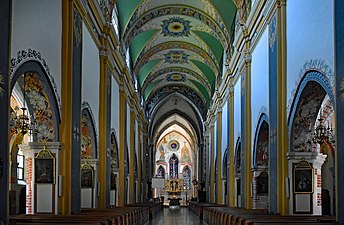| Opactwo Cystersów w Mogile | |
 Front view of Mogiła Abbey with the Basilica of the Holy Cross to the left Front view of Mogiła Abbey with the Basilica of the Holy Cross to the left | |
 | |
| Monastery information | |
|---|---|
| Order | Cistercians |
| Established | 1222 |
| Archdiocese | Kraków |
| People | |
| Founder(s) | Bishop Iwo Odrowąż |
| Abbot | Piotr Chojnacki, O.Cist. |
| Architecture | |
| Style | Polish Gothic and Renaissance |
| Completion date | 1225 |
| Site | |
| Location | ul. Klasztorna 11, Kraków |
| Country | Poland |
| Coordinates | 50°3′52.3″N 20°03′9.9″E / 50.064528°N 20.052750°E / 50.064528; 20.052750 |
| Website | www |
| Historic Monument of Poland | |
| Designated | 2023-09-05 |
| Reference no. | Dz. U. z 2023 r. poz. 1867 |
Mogiła Abbey (Polish: Opactwo Cystersów w Mogile; Latin: Abbatia B.M.V. de Clara Tumba) is a Cistercian monastery in the Nowa Huta District of Kraków, Poland. The abbey was founded in 1222 by the Bishop of Kraków, Iwo Odrowąż. The religious complex was built for religious reasons as well as for prestige. It was the largest and most impressive church in medieval Poland after Wawel Cathedral, and served as the Odrowąż family's burial place until the 16th century.
The architectural complex includes the stuccoed Polish Gothic church, the Basilica of the Holy Cross (Polish: Bazylika Krzyża Świętego), which serves as the Parish Church of St. Bartholomew the Apostle as well as the abbey church for the monks. There is also the Polish Renaissance-style abbot's palace, built around 1569, as well as the red-brick monastery, with a broad inner courtyard, outbuildings, vegetable garden, greenhouse, etc.
History
Under the reign of Henry I the Bearded, the Duke of Silesia, a community of monks was brought in from Lubiąż Abbey to Mogiła by Odrowąż around 1219, to commence the construction of the brand new church in his diocese. He granted them a village by the Vistula River, close to his residence in the capital. The monastic community, consisting of the 13 professed monks mandatory for an independent monastery, moved in around 1225, although the expansion of the abbey continued for years to come. The Mogiła Abbey was confirmed by the Roman Curia through a papal bull signed by Pope Gregory IX on 9 June 1228. In Latin, the monastery still retains its name of Clara Tumba (Bright Tomb), a name derived from two local toponyms. There is an ancient barrow, called Wanda Mound, within a mile of the monastery site; and the name of the site of the monastery, originally the village of Mogiła, translates as "tomb" in Polish.
In 1241 the abbey was ransacked in the course of the Mongol invasion of Poland. It was rebuilt and the abbey church was consecrated in 1266 by Bishop Jan Prandota. It was later consumed by fire in 1447. It was ravaged again in the 17th century by the invading Swedish army. The abbey was destroyed and its entire resident population was killed by the Swedes, except for two monks whose lives were spared. The structure was renovated numerous times. The Baroque façade of the monastery church was added in 1779–80, based on a design by Franz Moser.
The abbey church was promoted in 1970 by Pope Paul VI to the rank of a minor basilica, and visited by Pope John Paul II, who celebrated Mass for 200,000 people in a nearby open field in 1979.
Notable individuals
Under the reign of Abbot Erazm Ciołek (a relative of the noted scholar, Bishop Erazm Ciołek of Płock), who was elected as abbot in 1522, the abbey was restored to its former glory, with a greatly expanded collection of rare books. He died two years after being appointed the Vicar General of the Archdiocese of Kraków in 1544, and was buried in the abbey cemetery.
This abbot employed the services of the Polish Renaissance painter Stanisław Samostrzelnik, known also as Stanisław z Mogiły (c. 1490–1541), who spent his final years working at the abbey, where he died. His frescoes are featured in the right-hand transept and in one of the chapels of the monastery church, including his painting on the forward wall of the chancel from c. 1530.
Gallery
References
- Rozporządzenie Prezydenta Rzeczypospolitej Polskiej z dnia 5 września 2023 r. w sprawie uznania za pomnik historii "Kraków - opactwo Cystersów w Mogile", Dz. U., 2023, No. 1867
- "Elenchus Monasteriorum Ordinis Cisterciensis" (PDF). Cistercian Order. p. 45.
- ^ Marek Strzala (2013). "Krakow's Cistercian Abbey of Mogila". Krakow Info. Retrieved 24 July 2013.
- ^ Krzysztof Jankosz (15 July 2013). "Ogród Opactwa Cystersów w Mogile". Official website. Opactwo Cystersów w Mogile. Retrieved 24 July 2013.
Abstract in English: "The Sanctuary Of The Holy Cross Of The Cistercian Abbey In Mogiła."
{{cite web}}: External link in|quote= - ^ Iwo Kołodziejczyk (15 July 2013). "Omodlone wiekami miejsce". Source: "Głos – Tygodnik Nowohucki", 8 Sep 2000, nr 37 (492), pp. 1 / 9 (in Polish). Opactwo Cystersów w Mogile. Retrieved 24 July 2013.
- ^ Opactwo Cystersów (2013). "Historia. Proces fundacyjny klasztoru Cystersów". Obiekty cysterskie w Polsce (in Polish). Szlak Cysterski. Retrieved 24 July 2013.
- ^ Teresa Czerniewicz-Umer (19 April 2010). Cracow, Area by Area: Mogiła. Penguin. p. 154. ISBN 978-0756670870.
{{cite book}}:|work=ignored (help) - Garry O'Connor (22 August 2013). Universal Father: A Life of Pope John Paul II. Bloomsbury Publishing. p. 186. ISBN 978-1408847077.
- Halina Kowalska (2003). Contemporaries of Erasmus: A Biographical Register of the Renaissance and Reformation. Peter Gerard Bietenholz, Thomas Brian Deutscher. University of Toronto Press. pp. 304–305. ISBN 0802085776.
{{cite book}}:|work=ignored (help)
External links
- Opactwo Cystersów w Mogile Mogiła Abbey homepage. (in Polish and English)






